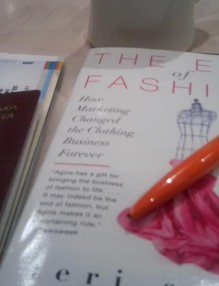Fashion and capitalism synergy – why fashion development is possible only in rich countries? PART 1
by Kasia Gola
It wont be my typical ‘why IT connects to fashion’ post. But it’s still geeky 🙂
I will share with you my “Varieties of Capitalism” essay, that I have written few days ago. It’s not an example of English mastery, but my teacher gave me 4.5 (B+), so it can’t be that bad :D.
Fashion and capitalism synergy – why fashion development is possible only in rich countries?
Introduction
Fashion is one of the most important issues in people’s everyday life. Through the ages it was pathing the way of our civilization. Even in ancient ages men and women were showing their class belonging by apparel, jewelry and make-up. Fashion sociology classicist – Simmel, said that everyone was involved in fashion, even by being a fashion non-conformist. Fashion industry is also strongly connected to economy and capitalism progress. Economic liberty was one of the most important issues in fashion, especially haute-couture industry. In today’s world, the biggest companies are in fashion sector and by PR, branding and marketing – almost everything is connected to fashion – from music and movie industries to IT. It is important mainly in capitalistic countries, especially in Europe and the USA, but also in Japan and Australia. It also matters in regions where it is manufactured, like China, India, Phillipines, Malaysia, Indonesia, Bangladesh, Sri Lanka, Pakistan or Thailand. On the other hand, it was not so important in communistic Europe and definitely, it does not matter in regions like today’s North Korea. Obviously, it does not mean that people were not interested in fashion, it only means that textile and fashion industry did not work properly. There is a strong fashion-capitalism synergy: Only the relevant conditions of the economy and being open to the foreign investors help to develop the fashion industry, even if it’s only in the sphere of manufacturing. It gives a good base for fashion evolution. By writing my essay I am going to prove that this connection is extremely strong and that economy and fashion always have and, probably, always will depend on each other.
-
as a norm – people may agree with it or rebel against it
-
as a historical process – people change their mind about fashion, from the acceptation to the negation
-
as an auto destructive process – every breakdown has the beginning in the success
-
the fashion leader – person who is the best in following fashion trends is a fashion leader at the same time.
This is a classical theory, which shows us contradictions in fashion. His theory is more micro-sociological than macro, but it shows that fashion is a process, it contains changes and changes are possible only with sufficient amount of information – which is possible in democratical systems. Although, Simmel’s thoughts are not the most up-to-date, he is considered as a father of a fashion sociology and in my opinion his concept is still actual. Other classicists like Thorstein Veblen claims that fashion is made and consumed only by the rich#. More contemporary researcher, Fred Hirsch says that after satisfying the basic needs, people compete in a senseless fight. The battle for power and social position#.
On the other hand, Karl Marx – the guru of communists – believed that people are involved in a superstructure, systems which are given in a capitalistic society. To his mind, the revolution is the only one solution to cure society. People are divided on two classes: labor class and capitalists, which are both affected by ill system. Capitalists use labor and they are the owners of workers’ tools. Culture is one of ways to false consciousness of both class, especially labor. He thought that revolution and communism are the best answers. It’s important to remember that Marx theory was utopian, history verified how people interpreted his believes. Simplifying, the communism, as a system based on Marx’s theory, was about averaging of capitalists’ and labor quality of life – to make the rich poorer and the poor richer.
Sources:
- Simmel G., Fashion, Source: The American Journal of Sociology, Vol. 62, No. 6 (May, 1957), pp. 541-558 Published by: The University of Chicago Press Stable URL: http://www.jstor.org/stable/2773129
- Veblen T., Teoria klasy próżniaczej, Warszawskie Wydawnictwo Literackie MUZA, Warszawa 2008, p. 60-87
- Harkin J., Trendologia: niezbędny przewodnik po przełomowych ideach, Wydawnictwo ZNAK, Kraków 2010, p. 88-89
- http://www.kristisiegel.com/theory.htm

Previous:
Dolce &Gabbana on how the Internet and Social Media have changed Fashion industry

Next:
Fashion and capitalism synergy PART 2
You may also like
-
 12 Dec
12 DecBeautiful Holiday Animation by Burberry
fashion marketingBurberry wishes its’ mailing subscribers a magical festive season and sends them an amazing, beautiful Holiday ...
-
 24 Jan
24 JanWhat is ACTA and how can it affect fashion bloggers?
fashion marketingChaos, chaos, chaos… Today’s post is devoted to ACTA issue, because in Poland it’s a ...
-
 12 Jun
12 JunMarketing in fashion, where to find the information?
fashion marketingLately, I gave up my faith in the marketing literature, especially in the fashion marketing. Frankly, ...
-
 16 Dec
16 DecThe End of Fashion: how marketing changed the clothing business forever vs. how the Internet and Lady Gaga saved Haute Couture
fashion marketingRecently I’ve read Teri Agins’s book titled The End of Fashion: how marketing changed the ...

Comments are closed.